Studio Visit
On a Centuries-Old Dutch Farm, Artist Saskia Noor van Imhoff Learns the Secrets of the Land
The artist's solo show "Mineral Lick" is currently on view at Grimm Gallery in London.
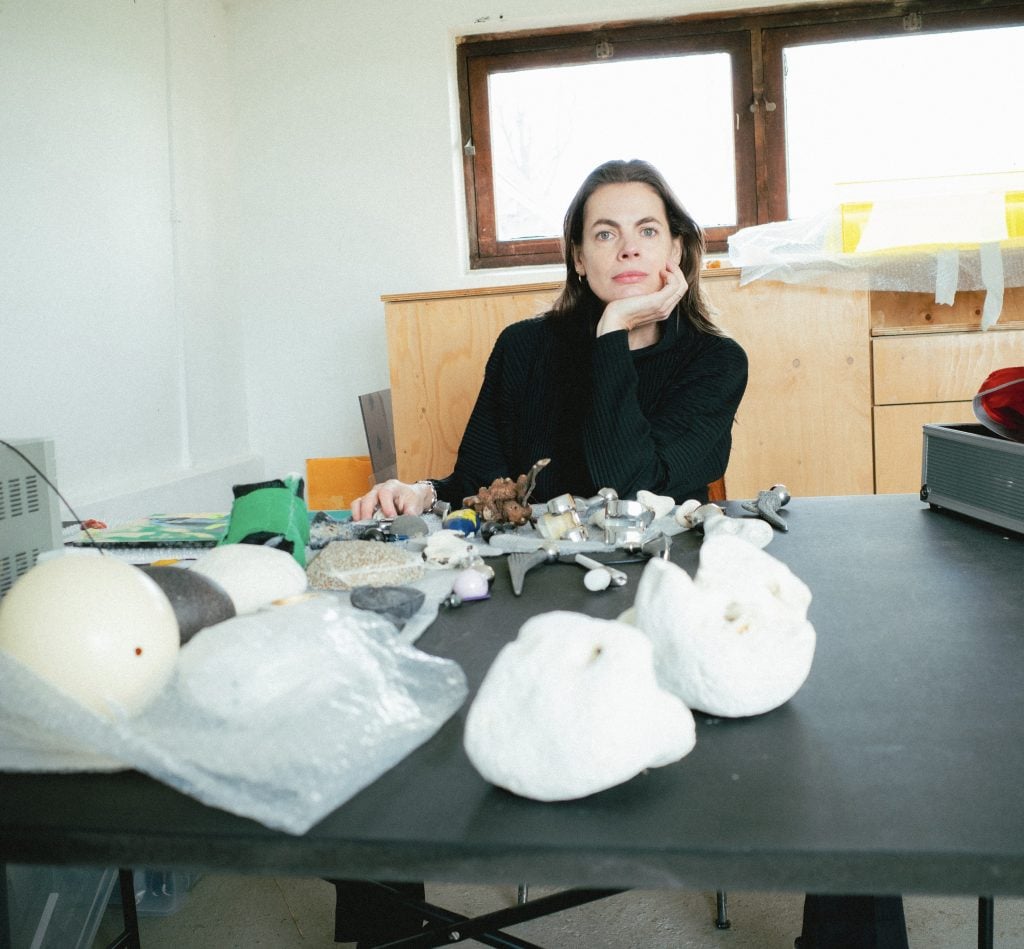
The artist's solo show "Mineral Lick" is currently on view at Grimm Gallery in London.

Margaret Carrigan

Conceptual artist Saskia Noor van Imhoff has long explored the systems and structures that undergird collecting and valuation. She is known for her site-specific installations at museums and galleries in which she carefully examines the architecture of objects within a space, presenting them in a non-hierarchical way that forces the viewer to reassess how we organize and classify the world around us.
Over the last couple of years, she has expanded her view to the great outdoors, a move spurred in part by the purchase of a plot of rural farmland on the northern coast of the Netherlands that she and her partner turned into a living space, a studio, and an ongoing work in and of itself.
A former Dutch dairy farm, the property bears the marks of hundreds of years of human inhabitance—and millennia of animal and vegetable residence. Van Imhoff has dubbed it an “organic collection,” and the process of documenting and restoring the site has become an outgrowth of her artistic practice as she creates sculptures and installations that draw in and recast elements of the land. The result is an ongoing body of work that questions predefined notions of animal-human hierarchies and explores how to be a good steward of something so vast.
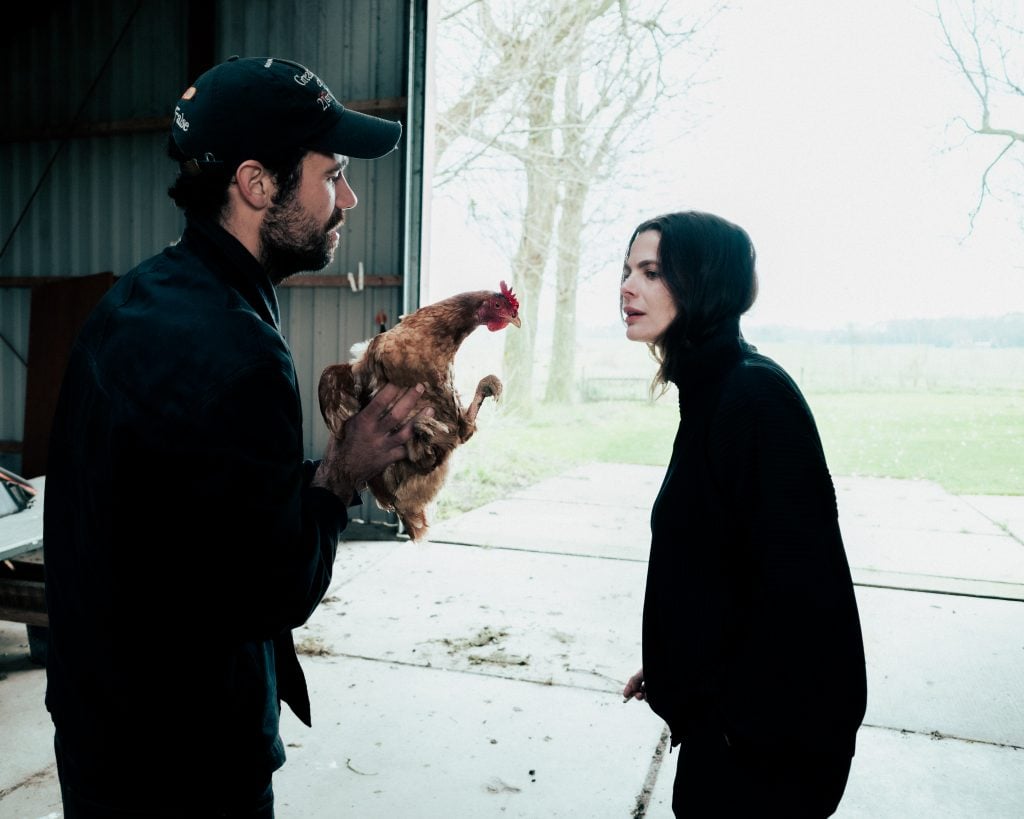
Van Imhoff inspects a chicken at her studio, located on a former farm. Photo: Nicola Lanburov.
In her latest show, “Mineral Lick”, currently at London’s Grimm Gallery, she recontextualizes found objects from the former farmstead. Among these are old wood beams and tree roots that she “grafts” her own bronze and aluminum sculptures onto, at once memorializing the original materials while propagating something new. Sculptures like those for which the show is named are cast from mineral licks—blocks of salt and nutrients that are fed to a nearby farm’s barn-bound livestock that never see the light of day—recalling not only the history of the land as a dairy farm but also questioning the degradation of life in pursuit of pure production.
Born in Canada, Van Imhoff was raised in the Netherlands and is now based in the northerly Dutch village of Mirns, where we reach out to her to learn more about the vast and wild studio space she maintains there, and how her relationship with the land directly informs her work.
Can you tell us about your studio? Where is it located, how long have you been there, how would you describe it…?
The studio is on an old farm situated in the Gaasterland, in the southwest corner of Friesland, in the Netherlands. It’s about an hour and a half north of Amsterdam. The property consists of 2.5 acres of land with a farmhouse from 1873 that my family lives in. The land has been in use as a dairy farm for almost 400 years.
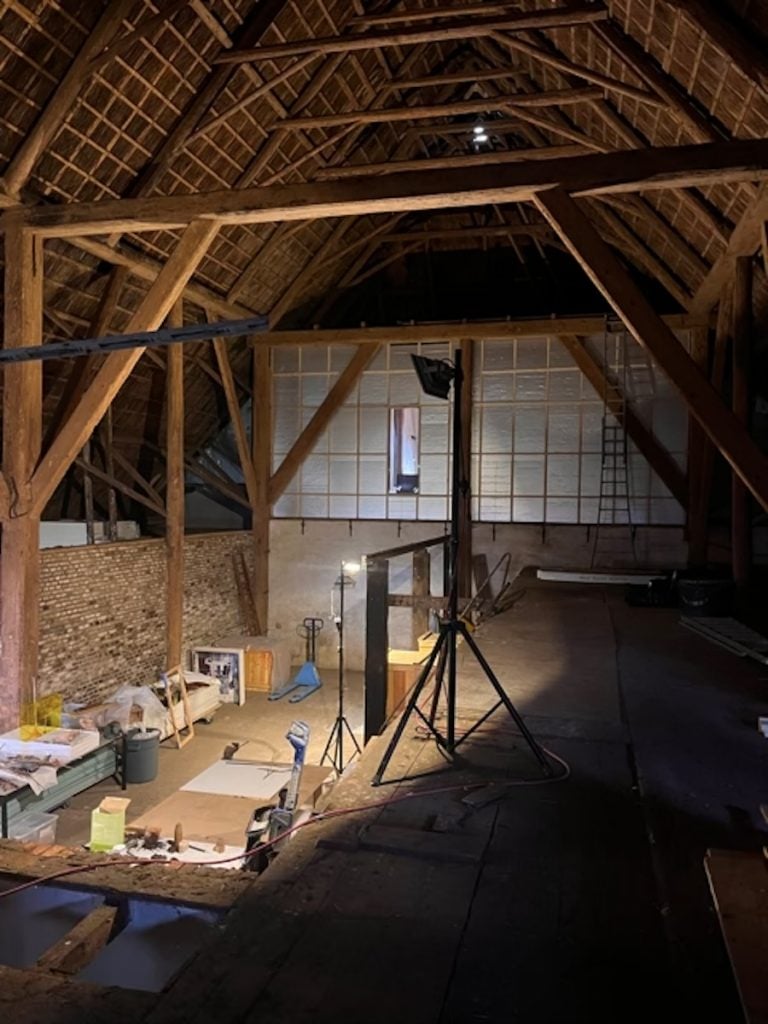
Saskia Noor van Imhoff’s studio is located in a 19th-century dairy barn. Photo: courtesy of the artist.
The plot is surrounded by rolling grasslands, old forests, IJsselmeer (Lake IJssel), bird reserves, and the Frisian Lakes. It’s very beautiful, it sometimes feels like the end of the world but it’s really a no man’s land; we are far from everything, there’s nowhere to just, like, get a coffee or anything.
We bought the farm about two years ago. My partner, designer Arnout Meijer, and I cultivated a smaller plot closer to Amsterdam before this and decided we wanted to do more, to take care of more. We have been trying to get it to a better place since taking it over. “A better place” may sound a bit too romantic, but it was in a very weird, depleted condition when we bought it. Despite all of the green, it had been a long time since the land would be what you could call “natural.”

Saskia Noor van Imhoff has planted nearly 4,000 trees on a former dairy farm that she has turned into her studio space. Photo: courtesy of the artist.
It has been shaped over centuries by human use: the meadow is a polder created in 1632, the forests were planted by an Amsterdam regent family in the 18th century as an ornamental park behind their mansion, and with the construction of the nearby Afsluitdijk dam in 1932, the IJsselmeer was born, which totally changed the ecosystem.
My partner and I have been diving into the land’s history, and to revive it, we have planted wildflowers and nearly 4,000 trees to replace the ones removed over so many centuries to make way for grass and farmland. The trees are still very small, though. There are lots of creatures here, I’ve set up wildlife cameras all around the farm to see who we are living with. Most of them come out at night: roe deer, foxes, badgers. And roughly from October until April the area is full of hundreds or thousands of Greater white-fronted geese, greylag geese, and Barnacle geese. In the rest of Friesland they can be chased away, but here is a protected foraging area.
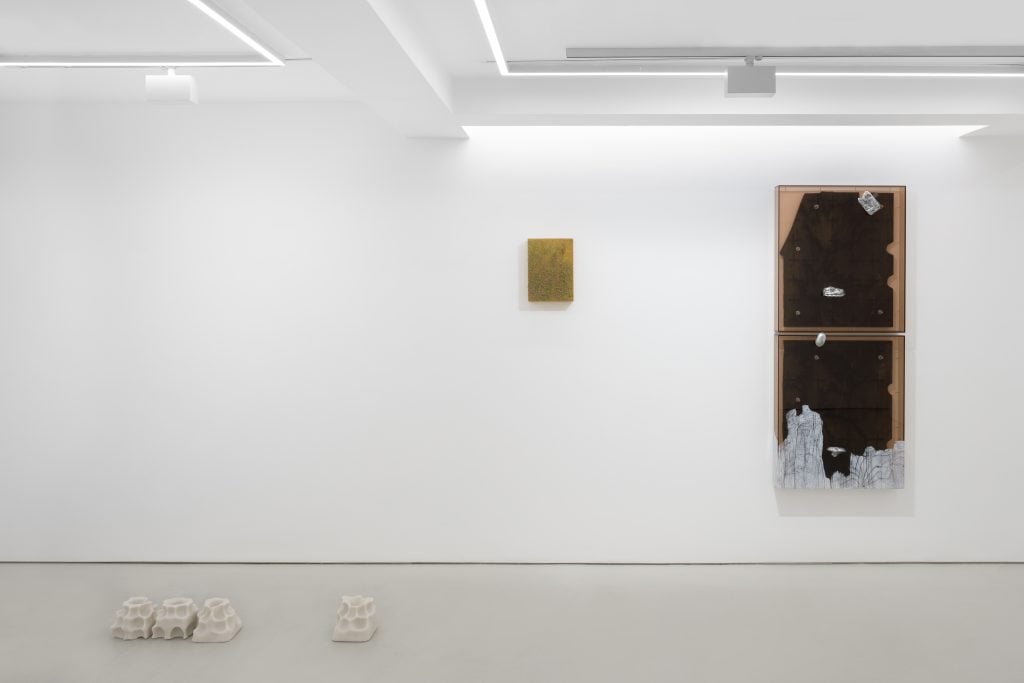
Installation view of “Mineral Lick.” Courtesy of Rob Harris and GRIMM London, Amsterdam, New York.
What do you like to look at or listen to while you’re working? And does the atmosphere of your studio influence the way you work?
Since we moved here, we have been converting the barn into a workspace, but I think of the land around it as my studio, too, I can work everywhere. The buildings, yard, and soil all bear the marks of the past. I think every material has this kind of forgotten memory in it and we only look most of the time at the surface. In my practice, I always like to kind of “open up” forgotten places.
In the process of cleaning out the barn and the farmhouse here, I started thinking about it as sort of an organic collection that I have to care for, and elements from the property and the land have all found their way into my work. I still have a studio space in Amsterdam, too, which is more traditional; I use that for doing more documentation and archival work. But here it is maybe more freeform, it all infuses with my work.
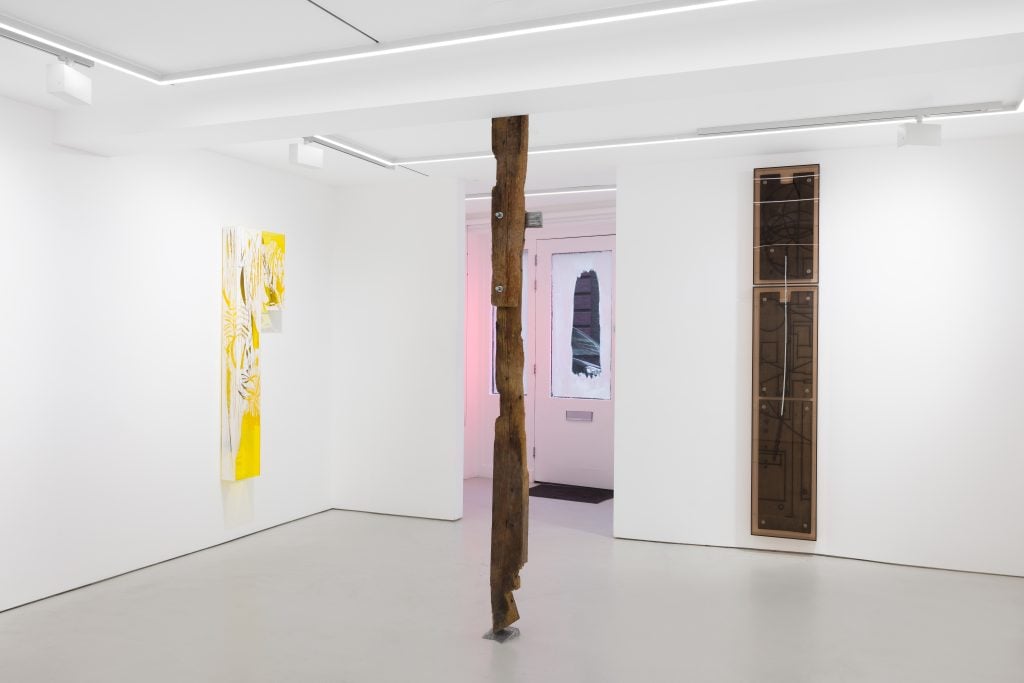
Installation view of “Mineral Lick” 2024. Courtesy of Rob Harris and GRIMM London, Amsterdam, New York.
I don’t really listen to music or anything while I work, I am a quiet worker in that sense. Some people always must have on their noise-canceling headphones. I think it is important to be aware of your surroundings, to hear what’s in your environment, to be a part of it. If I am listening to music or a podcast, it’s too much on top of my own thoughts.
When you feel stuck while preparing for a show, what do you do to get unstuck?
I feel like I just stay curious. A lot of my work is about researching and investigating—peeling back the layers on something—so if it is taking me somewhere I didn’t expect, I don’t feel stuck, per se… what I am finding just becomes a new aspect of the work.
What are some of the materials from the farm that have made your way into your latest works?
Some of the beams from the buildings here are in the show, in works like Heritage (Wood). The barn and farmhouse are 150 years old, but we did some research on them and found that the wood beams are way older. The wood was brought in from White Russia and Norway. The green patina of the copper nails in some beams indicates the reuse of centuries-old wood of ships. Beams supporting the subfloor are half-painted with floral motifs from a previously demolished house.
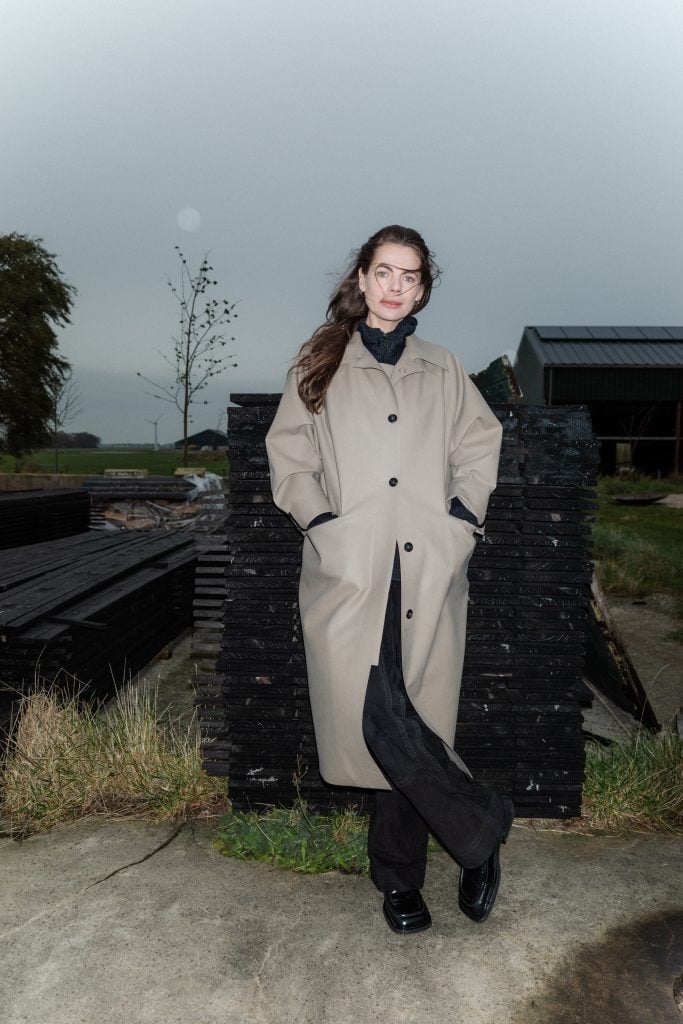
Saskia Noor van Imhoff stands in front of old wood and materials from the former farm buildings on her property. Photo: Nicola Lanburov.
What is your favorite tool, medium, or other art supply that you love working with most, even if it’s not often? Alternatively, is there anything someone might be surprised to find in your studio?
I work across so many different mediums, so I wouldn’t say I have a favorite. I like to stay a bit clumsy—I don’t get to know a tool or a medium too well because then I become quite beholden to the way it “should” be used. But I use a shovel quite a lot, I suppose that is not so common of an artist’s tool! But if you see your land as a studio, then it is normal to use a shovel, I suppose.
“Saskia Noor van Imhoff: Mineral Lick” is on view at Grimm Gallery, London, through April 6, 2024.